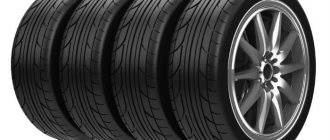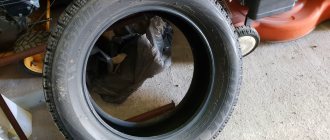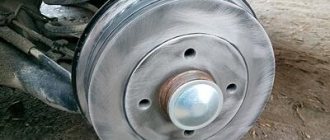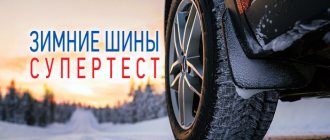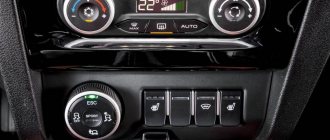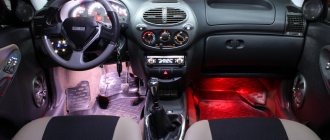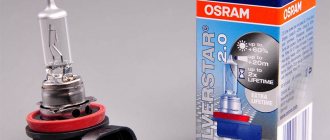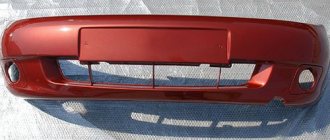Selection of winter studded tires for Lada Kalina-2
In the “Lux” trim levels of Lada Kalina-2 cars, alloy wheels with a diameter of 15 inches are installed from the factory. For more affordable versions, such as “Norma”, “stamping” with a diameter of 14 inches is standard. VAZ installs only universal, that is, all-season tires on all new cars. Of course, if we are talking about a crossover, the buyer will be offered universal Pirelli tires. However, the option of using all-season tires is not suitable for winter. Let's consider what is better to choose for a station wagon and for a hatchback of the “berry family”, if we are talking about the need to install a “spike”.
Review of the best summer and winter tires
Car tires require special care when choosing, and that is why care is needed here. Lada Kalina puts forward its own requirements for car tires, so it is important to consider the points individually when selecting winter and summer options.
Basic summer tires
Nokian Hakka Green 2 is a popular option for summer car tires that ideally combines quality, reliability, practicality and functionality. Reasonable cost and quality from manufacturers are the main advantages.
Continental ContiPremiumContact 5 is the second most important option, the cost of which is an order of magnitude higher than that of the Nokian, but at the same time the quality is slightly different, inferior by literally a couple of points.
Formula Energy is an option that is almost half the cost of the previous one, but is in no way inferior in quality. If you are on a limited budget, this tire option will be ideal.
Hankook Kinergy Eco 2 are well-known summer tires for cars, and they combine quality, reliability, attractiveness and affordable price. All this became the basis for the development of popularity. But, as practice shows, there are certain differences in quality, so it’s difficult to call such rubber durable.
Goodyear EfficientGrip Performance is a combination of a well-known brand and a fairly high cost because of it, so there is a need to rationally consider the options. It is also important to note that the quality, as practice has shown, is slightly different from current offers.
Winter tires for “Standard” and “Norma”
Those who purchased a car with a 14-inch “stamping” are in the most advantageous position. In this case, the owner will be able to choose anything from a huge list of studded tires, including imported ones. AvtoVAZ recommends using the following sizes:
For winter, obviously, the first option is suitable: narrower tires have better cross-country ability.
It must be remembered that the use of tires of any size other than those recommended may void the suspension warranty. You can choose the most suitable size using the table below. The best option will be highlighted in black.
Each cell of the following table contains the outer diameter of the wheel:
See column number 14
As a result of tests carried out by different publications, a list of products that meet the above goals was formed. The list contains the names of brands under which studs of size 175/65 R14 are offered:
- Hakkapeliitta 8 – good grip properties, even on ice. Add to this high cross-country ability and low fuel consumption. Comments can be made regarding directional stability in the snow.
- Continental ContiIceContact - the owner can count on ideal traction properties, including on ice. Good braking on asphalt is guaranteed, but fuel consumption will be quite high.
- Michelin X-Ice North 2 - the balance of all indicators is complemented by good grip properties demonstrated on snow. Fuel consumption will be low, but increased noise will be noted.
- Gislaved NordFrost 100 – ideal deceleration on wet asphalt. To it we must add good handling, as well as stability and cross-country ability in winter.
- Nokian Nordman 4 – option suitable for snow and asphalt. Fuel consumption will be moderate, but braking on dry asphalt will not bring pleasant emotions.
- Kama EURO 519 – poor deceleration on wet asphalt, and in general, these tires are only for snow.
- Cordiant Polar 2 – the worst grip on snowy roads, high fuel consumption. There are no comments only when driving at low speeds.
- Amtel NordMaster ST is an asphalt tire that holds its course well on snow.
Studded tires on 15-inch alloys
Instead of purchasing a “winter” set of wheels (175/65 R14), sometimes owners prefer to “change” their cars for the winter. For 15-inch wheels, one recommended size is 185/55 R15. However, judging by the reviews, it makes sense to take a closer look at the “185/60 R15” studs. However, switching to this option will result in loss of warranty. Let's leave the choice to the car owner.
What's on the right is not recommended
The following comments are often made about using lower profile tires:
The 60th profile is always cheaper than the 55th. In general, size 185/60/15 is more popular. Installing tires with a low profile (185/55 R15) increases fuel consumption.
Everything said here may be true. Only now, violation of VAZ recommendations leads to termination of the warranty, and in 100% of cases. Therefore, we will try to choose “spikes” of the following standard size – 185/55 R15:
- Hakkapeliitta 7 – tires designed for snow and asphalt at the same time. Good results when braking on a straight line. Good handling on snow and ice. However, “spikes” are poorly designed for dry asphalt.
- Goodyear UltraGrip Ice Arctic - good snow traction, but the sidewall is too soft. Increased noise is typical only during the break-in period.
- Br>
The information provided here is relevant for the 2014-2015 season. Perhaps in 6 months it will be possible to add to the list.
The option of purchasing R14 wheels intended “for winter only” is quite adequate. However, it is not optimal in terms of cost. The owner will decide what exactly to prefer in this or that case.
Are winter tires dangerous in summer?
The period when motorists en masse change their winter tires to summer tires will begin in just a few weeks. But is off-season use really dangerous for the wheels, and what will the driver face from the traffic police for this?
Various things happen in life, and therefore you should not promise that you will not find yourself in a situation where you have to travel along the roads of our vast car, “shod” with wheels that are not suitable for the season.
If, for example, you drive around the city in the summer with the windows open, after a very short time you realize: there are a lot of cars around, their winter studded tires clicking on the sun-hot asphalt. What actually threatens the car and its owner when driving on winter wheels? Maybe it really can be used all year round?
At first glance, this is exactly the case: after all, if rubber provides traction on slippery roads in winter, then in summer it is even more capable of doing so. In addition, if we are talking about non-studded Velcro, then winter tires are considered quieter precisely due to the softer rubber compound used in them. However, there are also a lot of disadvantages to using winter wheels in summer.
Just because the tire material is more elastic, its strength noticeably decreases in hot weather. In addition, the braking distance of the car increases: according to various estimates, by 1.5-2 body lengths, if we are talking about a passenger car. How much this increases the risk of an accident is clear to everyone. And controllability decreases.
The “winter” configuration of the pattern, together with the increased softness of the wheel material due to the heat, makes the tread “blocks” more prone to breaking when turning and changing lanes of the car. The “tailoring” of winter tires to work in conditions where the water is mostly in a solid state results, other things being equal, in a greater tendency of the wheels to hydroplane. This also does not improve road safety.
Well, of course, softer winter tires wear out much faster in the summer heat compared to summer tires. The same softness leads to the fact that in the warm season, the fuel consumption of a car “shod” in winter tires can increase by 10-15% due to an increase in rolling resistance.
From a legal point of view, driving in summer on winter tires is contrary to the requirements of the Vehicle Safety Regulations. This document directly states that “in the summer (June, July, August) the use of vehicles with wheels with winter tires is prohibited.” For violation, Article 12.5 of the Code of Administrative Offenses even provides for punishment in the form of a warning or a 500-ruble fine. But which driver will remember that the traffic police officer who stopped him began to look for markings on the tires?
Therefore, if for one reason or another you find yourself with your four-wheeled friend in an area exposed to such temperatures, especially on the highway, it is better to mount winter tires in advance.
In populated areas (excluding mountainous and very hilly areas), it is possible to drive on summer tires even until the first frost. I cannot recommend this, but as a necessary measure it is quite viable. From experience, I also cannot help but notice that in the case of terrain with a significant difference in elevation or long gentle descents/ascents, especially when driving at speeds of more than 80-90 km/h, it is safer to switch to winter wheels in advance. Firstly, you will have time to get used to the peculiarities of the behavior of your iron horse on soft tires. Secondly, as always, the “unexpected” glaciation will not take you by surprise. Winter wheels will leave precious seconds (and fractions thereof) for maneuver and will allow you to overcome the extreme meters of a steep climb.
What does the Law say? Technical Regulations of the Customs Union “On the safety of wheeled vehicles” 018/2011, in particular paragraph 5.5, prescribes: “The operation of vehicles equipped with tires with anti-skid studs is prohibited in the summer (June, July, August).
It is prohibited to operate vehicles that are not equipped with winter tires that meet the requirements of paragraph 5.6.3 of this appendix during the winter period (December, January, February). Winter tires are installed on all wheels of the vehicle.
The terms of the operation ban may be changed upward by regional government bodies of the member states of the Customs Union.”
What winter tires should I put on the Lada Kalina Cross?
According to the Technical Regulations of the Customs Union TR CU 018/2011, all car owners in our country are required to install special winter tires on their cars for the period from December to February. Moreover, regional authorities have the right to extend this period depending on specific climatic conditions. In addition, the need for seasonal wheel changes is confirmed by studies of tire manufacturers, which indicate a serious deterioration in the properties of summer tires at temperatures below +7 degrees.
Thus, ensuring safe driving in winter has turned from an individual choice of conscious drivers into a mandatory law.
To choose the right wheels for the winter, Kalina Cross owners need to understand the conditions in which a particular car will be used, and also know how the performance properties of the car change depending on certain characteristics of winter tires.
Features of wheel inflation
To ensure comfortable and safe driving of the Kalina in winter and summer, it is necessary to measure the degree of tire inflation with a mechanical or electronic pressure gauge.
You can find the recommended tire inflation value on a Lada on the body on the driver's door or on the glove compartment door.
You will also see the optimal inflation mode in the table provided by each tire manufacturer. The values in it are adjusted depending on:
- number of passengers, luggage;
- car model (indicators for Grants, Priora and other Lada models differ depending on their weight).
Remember that the same pressure must be maintained in both winter and summer.
However, there is a nuance: if the Lada Kalina is parked for a long time in a warm garage or service station, prepare for a slight decrease in tire inflation after driving out into the cold.
Thus, you will have to inflate your car tires more often during the cold season.
Recommended winter tire parameters
According to the manufacturer's recommendations, the Lada Kalina Cross is equipped exclusively with 15-inch wheels with the following parameters:
- Bolt pattern: 4x98;
- Departure: ET 32;
- Centering hole diameter: 58.6;
- Rim width: 6.0J.
AvtoVAZ allows the installation of tires with dimensions 195/55/R15 85H on these wheels without restrictions on the choice of specific manufacturers.
For Lada Kalina Cross cars that are under warranty, you should select winter tires with the standard characteristics, otherwise service centers may refuse after-sales technical service. In addition, the design of the drives and steering, as well as the car’s suspension settings, are designed specifically for this wheel size.
Summer tires for Lada Kalina – what to choose?
Driving a car, in addition to the settings of the chassis and steering, directly depends on the tires. Therefore, the choice of summer tires for the Lada Kalina should be approached extremely responsibly. The purchased tires must provide the optimal balance between cost, safety and technical characteristics.
Therefore, it is necessary to consider some of the most popular models. In addition, it is worth taking into account the region in which the car is used – roads, climate and other issues.
For example, Krasnoyarsk has a temperate climate and high humidity, and therefore it is recommended to select tires for it on the portal shinapoint.ru/krasnoyarsk/. You can find a lot of offers on it and every motorist will choose the appropriate option. For St. Petersburg the criteria will be slightly different, etc.
Alternative winter tire options
In order to improve the driving characteristics of the car, many Kalina Cross car owners change the size of winter tires.
Wider tires increase the contact patch with the surface, which gives an advantage when driving on packed snow, but they are more susceptible to hydroplaning and are of little use for overcoming deep, loose snow.
Narrow tires, due to higher surface pressure, provide increased stability on icy roads and reduce braking distances. Also, wheels with a narrow tread push through loose snow porridge faster, reaching the hard surface.
High-profile winter tires are recommended for owners of Kalina Cross for driving on snow-covered roads; also, the increased tread profile will protect the wheel rims from damage when hitting large obstacles (stones, curbs) that are not visible under the snow.
The main rule when choosing non-standard size tires for Kalina Cross is that the total wheel diameter remains constant (within 2%): as the tire width increases, you should choose models with a smaller height. Standard winter tires 195/55/R15 can be replaced with tires 205 mm wide, but with a lower profile: 205/50/R15.
In the same way, you can reduce the diameter of the wheels used: when replacing 15-inch wheels with 195/55/R15 tires on 14-inch wheels, winter tires of size 185/60/R14 (difference 0.05%) or 175/70/R14 ( discrepancy 0.43%). As a result, without negative consequences for the suspension and drives, the car is equipped for winter trips with higher-profile and narrower tires. You should not install winter tires with a diameter larger than the standard 15 inches, even if visually the wheel arches of Kalina Cross allow you to accommodate 17-inch wheels. With such tuning, the load on the struts increases, comfort when driving over uneven surfaces deteriorates, and when turning and large suspension strokes, the tires touch the wheel arches.
Analysis of technical specifications
By default, Kalina is equipped with 13 and 14 inch wheels. Of course, they can be replaced with more massive ones without any problems, but we are talking about factory equipment. Acceptable sizes:
- 175/70 R13;
- 175/65 R14;
- 185/60 R14.
It is necessary to mention what functions winter tires perform and how they differ from summer tires. Its key difference is the rubber mixture itself and the freezing point. When driving a passenger car, the tires do not have an absolutely correct round shape. In this case, the skid would occur at every turn.
The tire is slightly compressed, due to which the friction force increases and the car maintains a clearly defined trajectory. However, at temperatures of +5°C and below, summer tires become very hard and retain their round shape, which reduces the area of their contact with the road. The result is lower stability while driving.
Winter tires freeze at lower temperatures (about -20...-30°C). However, on hot asphalt it becomes very soft. It holds its trajectory well, but wears out literally after a few hundred kilometers.
Based on all this, handling is affected by tire pressure, the load on each axle, and the total weight of the vehicle. Therefore, tires are selected with an emphasis on these characteristics, as well as on the driving style (but this is already a mediocre factor). So which tires are ideal for the Lada Kalina?
So, everything is clear with the sizes - they are static. But to ensure proper safety, you need to give preference to soft and medium-hard rubber, because the total weight of the car hardly exceeds 1.5 tons, which is only slightly higher than that of classic small cars. In turn, the tire pressure is maintained at 2.2 atmospheres for the front wheels, 2 for the rear wheels (without or with minimal load).
Wheel size is already a mediocre characteristic. Naturally, the larger the better, but you should not exceed 16 inches.
Choosing the type of winter tires
For winter operation of the Lada Kalina Cross in urban environments, where transport routes are regularly cleaned by public utilities, a suitable option would be to use friction winter tires (“Velcro”). Such wheels provide reliable grip on the road surface due to the presence of thin cross-sections - lamellas.
Friction winter tires are lighter and more durable than studded tires, have lower rolling resistance and uniform grip characteristics on all types of road surfaces.
However, Kalina Cross is positioned by the manufacturer as an all-terrain station wagon with increased ground clearance. This model is in demand among residents of rural areas and suburbs, therefore, in winter the machine is actively used in conditions of loose snow cover. Frequent trips on icy roads or roads covered with a layer of densely packed snow are also likely. In this case, installing studded tires would be the right choice.
Studded tires provide a shorter braking distance on snow and ice, but on clean asphalt they are inferior to Velcro tires in this indicator. Also, studded tires are characterized by a high level of noise when driving.
Additional information about the selection and rules for using various types of winter tires can be found in the following video:
When to wear winter tires.
Pajero mini
Manufacturers of winter tires, taking into account the peculiarities of their production, recommend installing their products at a time when the air temperature drops to 5-7 degrees. As a rule, during this period there are still small queues at car services, and this procedure will not bring unpleasant moments in the form of a large amount of time spent waiting for your turn. If for some reason you did not have time to do this before this time, then you should “change your shoes” in any case before the first snow or ice appears. Thus, changing tires on time will help you protect yourself and your car from an accident, but, unfortunately, it will not protect you from irresponsible drivers who did not do it on time
Therefore, in winter you need to drive with even greater caution and monitor the pressure in your car tires: a table with values will help you with this
What kind of winter tires should I put on?
Choosing winter tires among the huge assortment on the market is quite difficult, and when making a decision, trust first of all your experience, and if it is not enough, seek advice from familiar motorists, read reviews on the Internet, and study the factory characteristics of the tires. When selecting winter tires and making a purchasing decision, trust only trusted manufacturers. Although such products will be more expensive, they will last much longer than a cheap Chinese counterfeit. Many questions arise about the type of winter tires - studded or non-studded. The best option for you depends on the conditions in which you will operate your car, and therefore the tires. For example, studded tires (by the way, look at the rating of winter studded tires) perform best on snowy and icy roads, while non-studded tires perform best on dry or wet surfaces. The results of many tests have proven that the braking distance of studded tires on clean asphalt increases by 7%, while on ice it behaves 20% more efficiently. Which winter studded tires are best? Judging by the manufacturers, tires from such foreign companies have been showing consistently good results for several years now: Nokian, Continental and Michelin.
You can also stud tires separately by purchasing a product without studs, installing them yourself or at a car service center. But remember that not all tires can be studded, so before doing this, consult with specialists. Local body repairs should also be carried out with the help of specialists, or, if you have experience, you can do it yourself. According to the tread pattern, winter tires come in two types:
- Arctic (Nordic) tires (more suitable for clean road surfaces).
- European tires (designed for driving on snowy or icy roads).
In order to compare winter tires and understand which one you need, contact a tire specialist you trust, or rely on the opinion of more experienced friends who have tried different types of winter tires.
Almost all car services now replace tires, so you can “change your shoes” on almost every corner
The only thing worth paying attention to is the condition of the equipment and whether the service station workers have all the necessary tools. By the way, tire replacement can be done along with brake disc replacement, if necessary, of course. If your tires are equipped with rims, then you can put them on yourself, thus saving money and time. So, the time when to install winter tires is up to you, but you shouldn’t delay it, because choosing “shoes” according to the weather increases driving comfort and personal safety
